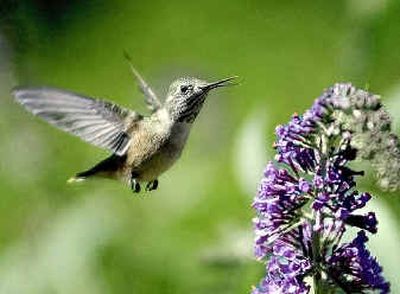Expect winter’s damage to leave lasting impression

Better add another tool to the garden shed this spring: patience. Damage from last winter is beginning to show up.
For starters, plants seem to be slow coming to life even though it has been warmer than usual. Give seemingly dead plants a few more weeks to show some life before you pull them out. The tops of some have died but they may come up from the roots. Others may sprout from parts of the trunks that were protected by snow.
There is some loss of plants put in during the last few months of 2003. Even normally hardy plants were killed. The likely reason is that the plants went into the winter under drought stress. They hadn’t been in the ground long enough to grow more roots and it was a dry fall. They simply did not have the resources in place to stay alive.
Plants with evergreen leaves like rhododendrons, boxwoods and laurels were winter burned or killed. The leaves on these plants continue to transpire during the winter. With the type of cold we had, the ground froze and the air was super cool, cutting off the water supply to the leaves. They basically dried out and died.
Boxwoods and laurels can be pruned back to new growth when — or if — it emerges.
Many rhododendrons lost their flower buds, and their leaves are showing winter burn damage. If there are green leaves on the plant, prune damaged stems back to a set of green leaves. The plant may send out new shoots from that point in a few weeks when its annual growth cycle starts. Rhododendrons put on new growth once a year after they flower and can only be pruned at this time.
If you have to replace them, check the label for an H followed by a number. Rhododendrons use a different hardiness scale than the USDA zone system we are used to. You want an H-1.
Think about replacing your large-leaf rhododendrons with the small-leaved PJM and its relatives. This group has the ability to roll its leaves up very tightly when it gets below freezing, which reduces moisture loss from the leaf. In the early spring, the plants are covered with an electric blue purple blossom.
Many butterfly bushes — or buddleia — died to the ground. Give these plants a few weeks to sprout from their roots before you pull them out. Because this plant is such an important nectar source for hummingbirds, bees and butterflies, be sure to replace it with a new plant.
Japanese maples took a double hit this winter. First, the trees did not have chance to go fully dormant before the October temperatures dropped suddenly. As a result, the leaves were left hanging on the tree. Then the January cold damaged some leaf buds. As a result there are reports of trees leafing out on their lower branches but not the top ones. Again, exercise patience. The tree has the ability to regenerate leaves.
Last but not least are the hydrangeas. We won’t know until later this summer but the cold probably got the flower buds and a lot of stems. Unfortunately, most hydrangeas produce flowers on wood that grew the previous summer. The plants are at their hardiness limit here and the buds are always the first part of the plant affected.
If you love the big leaf hydrangeas (Hydrangea macrophylla), take heart. A new variety called Endless Summer is being offered for sale for the first time this year. This hydrangea blooms on both old and new wood. This means that even if we get a hard winter, the plant will still bloom on wood it grows this spring.
The plant produces large colorful flower mops the entire summer season. The flowers are either pink or blue depending on the acidity of your soil. Alkaline soils with a pH of 6-7 will produce pink flowers while acid soils with a pH of 5-5.8 will produce blue flowers. The flowers can be changed from pink to blue by adding aluminum sulfate and blue to pink by adding dolomite lime to the soil. Both are available at local garden centers.
The plant grows to a height and width of 4 to 5 feet with age. Deadheading the spent flowers through the growing season encourages new flower production. The flowers can be dried and used in winter arrangements.
Endless Summer is available at independent nurseries including several in our area
Wildflower study at Turnbull Wildlife Refuge
On May 22 the Friends of Turnbull and the Northeast Chapter of the Washington Native Plant Society are joining forces to put on a wildflower study walk at the refuge. Meet at the Education Center at the refuge headquarters at 9 a.m. The class will last until about 2 p.m. Wear weather-appropriate clothing and bring a sack lunch. There is a $3 entrance fee to the refuge and a donation of $10 is being asked for the class. Turnbull is located south of Cheney.